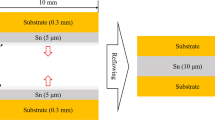Abstract
Solder joints between leads and printed circuit boards in thin small outline packages were produced with conventional Sn1.0Ag0.7Cu (SAC107) and Sn3.0Ag0.7Cu (SAC305) solders as well as various solder alloys with gradually increasing amounts of Bi (up to 3.0 wt.%) and In (up to 1.0 wt.%) within the SAC107 base solder. The reliability of soldered leads in temperature cycle (TC) tests improved most with solder alloys containing both Bi (1.6 wt.%) and In (0.5 wt.%). Microindentation and electron probe microanalysis mappings revealed that the effect originates from a combination of solution and precipitation strengthening of the initial SAC alloy. The distribution of inelastic strain accumulation (ISA), as a measure for degradation, was determined in the solder joints by finite element calculations. It was shown that defects in the solder proximal to the lead (<60–75 μm) strongly impact the reliability and provoke crack initiation around the defect where the highest ISA is located. In particular, similar TC performance can be expected for defect-free joints and for those whose defects exceed the threshold distance from the lead (>60–75 μm), which was underpinned by similar cracking characteristics along the lead–solder interface. The ISA was confirmed to be lower in SAC+Bi/In alloys owing to their enhanced elasto-plastic properties. Moreover, the addition of a thin Cu coating on the leads could improve the joint reliability, as suggested by the calculation of the ISA and the acceleration factor.
Similar content being viewed by others
References
P. Zacharias, Mater. Sci. Forum 615–617, 889 (2009).
M. Abtew and G. Selvaduray, Mater. Sci. Eng., R 27, 95 (2000).
K. Suganuma, MRS Bull. 26, 880 (2001).
Y. Zhang, H. Zhu, M. Fujiwara, J. Xua, and M. Dao, Scripta Mater. 68, 607 (2013).
F. Garofalo, Trans Metall Soc AIME 227, 351 (1963).
H. Ma and J.C. Suhling, J. Mater. Sci. 44, 1141 (2009).
R. Darveaux and C. Reichman, in Proceedings of the 57th IEEE Electronic Components and Technology Conference (2007). doi:10.1109/ECTC.2007.373872.
S. Wiese, A. Schubert, H. Walter, R. Dukek, F. Feustel, E. Meusel, and B. Michel, in Proceedings of the 51st IEEE Electronic Components and Technology Conference (2001). doi:10.1109/ECTC.2001.927900.
S. Wiese, E. Meusel, and K.J. Wolter, in Proceedings of the 53rd IEEE Electronic Components and Technology Conference (2003). doi:10.1109/ECTC.2003.1216277.
M.M. Basit, M. Motalab, J.C. Suhling, and P. Lall, in Proceedings of the 14th Conference on Thermal and Thermomechanical Phenomena in Electronic Systems (2014). doi:10.1109/ITHERM.2014.6892272.
P. Lall, D. Zhang, V. Yadava, and D. Locker, Microelectron. Reliab. 62, 4 (2016).
X. Hu, Y. Li, Y. Liu, and Z. Min, J. Alloys Compd. 625, 241 (2015).
A.A. El-Daly, A.M. El-Taher, and S. Gouda, J. Alloys Compd. 627, 268 (2015).
M. Berthou, P. Retailleau, H. Frémont, A. Guédon-Gracia, and C. Jéphos-Davennel, Microelectron. Reliab. 49, 1267 (2009).
M.A. Matin, W.P. Vellinga, and M.G.D. Geers, Mater. Sci. Eng., A 445–446, 73 (2007).
S. Park, R. Dhakal, and J. Gao, J. Electron. Mater. 37, 1139 (2008).
A. Hirose, T. Fujii, T. Imamura, and K.F. Kobayashi, Mater. Trans. 42, 794 (2001).
H. Iwanishi, A. Hirose, T. Imamura, K. Tateyama, I. Mori, and K.F. Kobayashi, J. Electron. Mater. 32, 1540 (2003).
T. Hiramori, M. Ito, Y. Tanii, A. Hirose, and K.F. Kobayashi, Mater. Trans. 44, 2375 (2003).
A. Hirose, H. Yanagawa, E. Ide, and K.F. Kobayashi, Sci Technol Adv Mater 5, 267 (2004).
Y. Sogo, T. Hojo, H. Iwanishi, A. Hirose, K.F. Kobayashi, A. Yamaguchi, A. Furusawa, and K. Nishida, Mater. Trans. 45, 734 (2004).
A. Yamaguchi, Y. Yamashita, A. Furusawa, K. Nishida, T. Hojo, Y. Sogo, A. Miwa, A. Hirose, and K.F. Kobayashi, Mater. Trans. 45, 1282 (2004).
B.Z. Hong, J. Electron. Mater. 26, 814 (1997).
D. Herkommer, J. Punch, and M. Reid, Microelectron. Reliab. 50, 116 (2010).
X. Li and Z. Wang, J. Mater. Process. Technol. 183, 6 (2007).
R. Dudek, W. Faust, J. Vogel, and B. Michel, in Proceedings of the 6th International Conference on Thermal, Mechanical and Multi-physics Simulation and Experiments in Micro-electronics and Micro-systems (2005). doi:10.1109/ESIME.2005.1502876.
J. Eckermann, S. Mehmood, H.M. Davies, N.P. Lavery, S.G.R. Brown, J. Sienz, A. Jones, and P. Sommerfeld, Microelectron. Reliab. 54, 1235 (2014).
S.M. Lee and K.W. Lee, Jpn. J. Appl. Phys. 35, L1515 (1996).
X. Zhang, S.W. Ricky Lee, K.S. Choi, and Y.G. Kim, IEEE Trans. Adv. Packag. 25, 514 (2002).
L.J. Ladani and A. Dasgupta, J. Electron. Packag. 130, 011008 (2008).
T. Siewert, S. Liu, D.R. Smith, and J.C. Madeni, Properties of Lead-Free Solders, Release 4.0, National Institute of Standards and Technology and Colorado School of Mine. http://www.nist.gov/mml/msed/solder.cfm. Accessed 11 February 2002.
Y.C. Chiou, Y.M. Jen, and S.H. Huang, Microelectron. Reliab. 51, 2319 (2011).
Acknowledgements
This work was partially supported by the Council for Science, Technology and Innovation (CSTI), Cross-ministerial Strategic Innovation Promotion Program (SIP), “Structural Materials for Innovation” (Funding agency: JST).
Conflict of interest
The authors declare that they have no conflict of interest.
Author information
Authors and Affiliations
Corresponding author
Rights and permissions
About this article
Cite this article
Lis, A., Nakanishi, K., Matsuda, T. et al. Finite Element-Assisted Assessment of the Thermo-cyclic Characteristics of Leads Soldered with SnAgCu(+Bi,In) Alloys. J. Electron. Mater. 46, 4326–4343 (2017). https://doi.org/10.1007/s11664-017-5384-1
Received:
Accepted:
Published:
Issue Date:
DOI: https://doi.org/10.1007/s11664-017-5384-1




